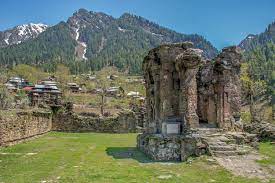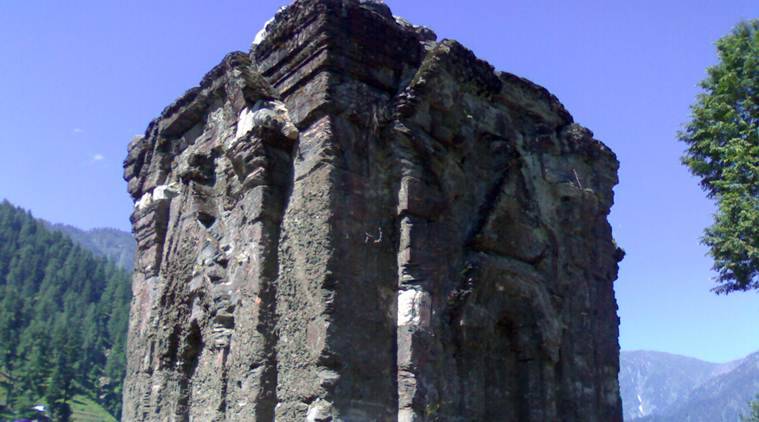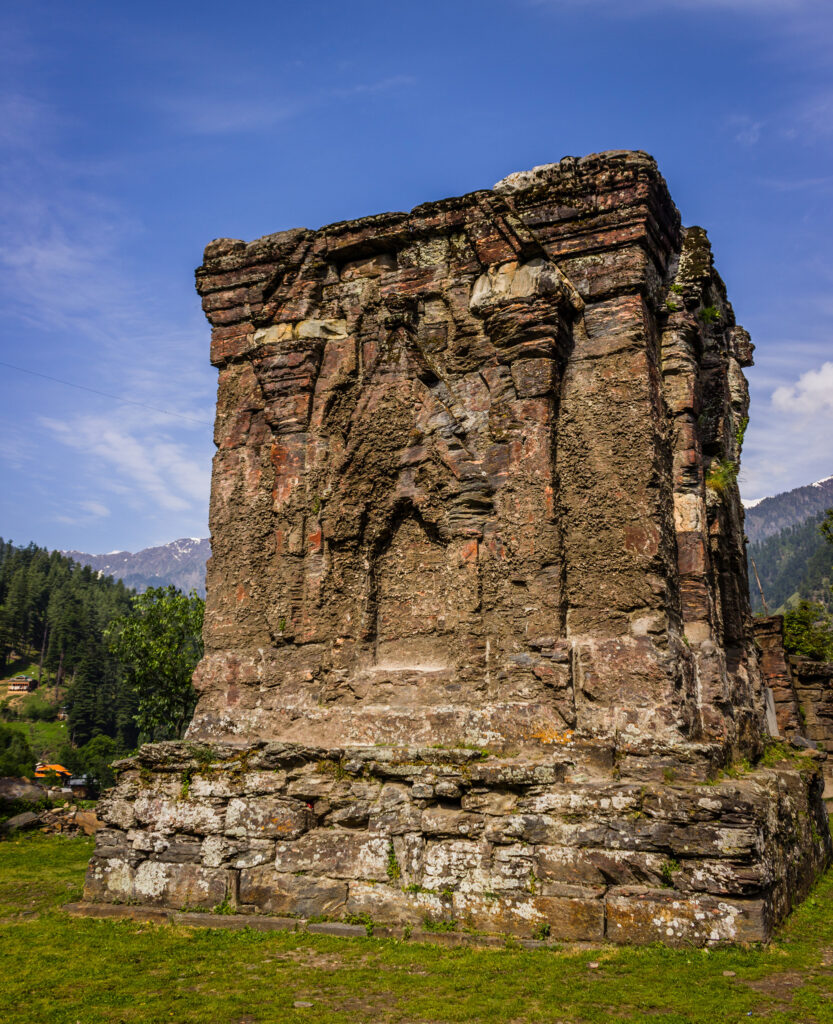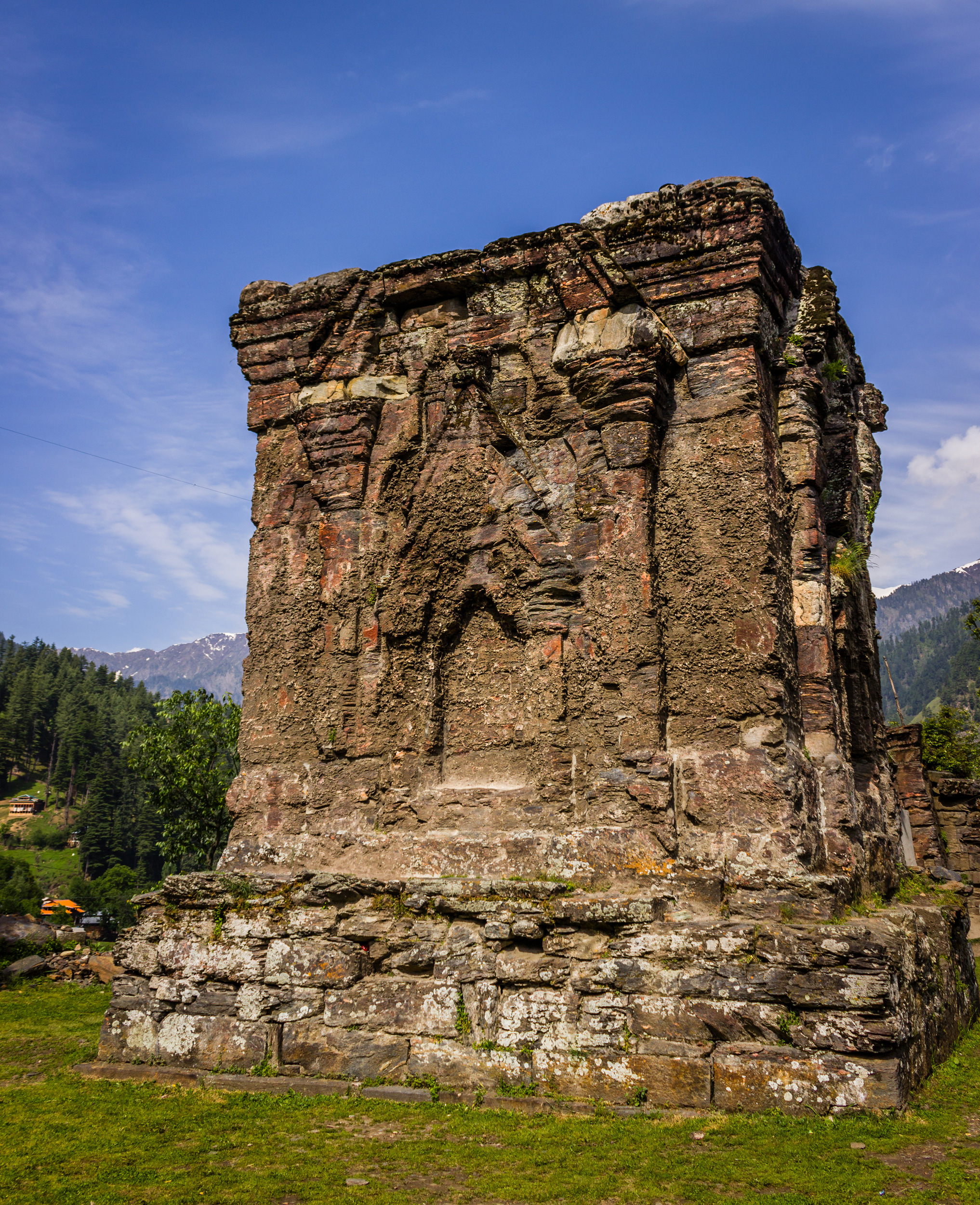The Sacred Site of Kashmir In the heart of the Kashmir Valley, nestled near the confluence of three streams, lies the legendary temple-cum-educational institution of Sharada Peeth, also known as the Sharada Amrit Kund. Believed to be the spiritual location of Goddess Sati’s fallen right hand, it is considered one of the three holiest pilgrimage sites for Kashmiri Pandits and a Maha Shakti Peetha.
By Satish Mahaldar
Sharada Peeth, also known as the Sharada Amrit Kund, is a sacred site in Kashmir and one of the Maha Shakti Peethas, believed by Hindus to be the spiritual location of Goddess Sati’s fallen right hand. The temple-cum-educational institution is located near the confluence of three streams in the Valley of Mount Harmukh. It is considered one of the three holiest pilgrimage sites for Kashmiri Pandits, along with the Martand Sun Temple and the Amarnath Temple.
Sharada Peeth is shrouded in mystery, with theories dating back over 5,000 years to the earliest records of Neolithic sites in the Kashmir Valley or the Kushan Empire. Some believe it was built by the Kashmiri king Lalit Aditya, while others think it was constructed in stages.

By the 8th century, the temple was a popular pilgrimage site, attracting devotees from far and wide. By the 11th century, it was one of the most revered Hindu temples in the Indian subcontinent, according to Al-Biruni’s chronicle of India. A curious account of the temple during Sultan Zain-ul-Abidin’s reign (1420-70) can be found in Jonaraja’s Chronicle. The king is said to have visited the shrine in 1422, but after witnessing the baseness of the people there, he failed to see the goddess visibly and materially. Despite his high personal qualities, the goddess refused to appear to him in a dream. The disappointment is said to have led to the goddess crushing her image to pieces.
Despite its rich history, the temple and its legacy continue to endure and inspire devotees to this day.
Legendary Origins of the Four-Armed Statue of the Goddess Sharada
A legendary statue of the Hindu goddess Sharada from the late 8th century AD has been discovered. The Sharada Sahasranama manuscript, written in the Sharada script and communicated by the last Purohit of the Sharada temple, is a key source of knowledge about the shrine. The manuscript recounts the story of Rishi Shandilya, who performed a grand Yajna in the Sharda area and was associated with various Hindu scriptures. He was the progenitor of the Shandilya gotra and known as the “Udara- Śāṇḍilya.”
Shandilya, who was the son of Devala and the grandson of Kassapa, is credited with writing the Shandilya Upanishad and the Shandilya Bhakti Sutra. He was instrumental in resolving certain metaphysical doubts about the two kings. Through a miracle at the Kishanganga spring, he achieved liberation from darkness and saw the goddess Sharada’s true form in the Sharada forest.
The sage then traveled through the Rangvor meadow, the Gostambhana forest, and arrived at Tejavana on the bank of the Kishanganga, where he saw the god Ganesha and finally reached the Sharada Vana. There, the goddess rewarded his long austerities by inviting him to her residence on S’risaila. Pitrs also approached Shandilya and asked him to perform their Shraddhs. Sharada considers the confluence of the Kishanganga and the Madhumati stream sacred. The name Sadri, now the designation of the village near the temple of Sharada, is derived from the goddess’s name.
Sharda Script
The Sharada Amrit Kund (Sharada Peeth) was a renowned Hindu temple and center of learning located in Pakistan-occupied Kashmir. The temple was known for its library, which was valued by scholars from across the Indian subcontinent, who traveled long distances to access its texts. Sharada Peeth played a crucial role in the development and popularity of the Sharada script in North India and was named after the script. By at least the 4th century CE, Sharada Peeth was considered a center of learning and was associated with prominent Buddhist scholars like Kumarajiva, Thonmi Sambhota, and Rinchen Zangpo. Other notable figures associated with the temple include the Kashmiri historian Kalhana Pandit and the Hindu philosopher Adi Shankara.
According to historical sources and various legends, Sharada Peeth was considered the center of learning and was renowned for its library. In the 11th century, Vaishnava saint Swami Ramanuja traveled to Sharada Peeth to consult the Brahma Sutras. In the 13th century, the Śvētāmbara scholar Hemachandra requested King Jayasimha Siddharaja to retrieve copies of Sanskrit grammatical texts from the temple’s library. The temple was also revered by the Kashmiri poet Bilhana.

In the legendary story related to the Jaina scholar Hem Chandra, King Jayasimha of Gujarat commissioned him to compose a new grammar and sent officials to the temple of Goddess Sarasvati in Kashmir to obtain the necessary manuscripts. According to the story, the manuscripts were delivered by the goddess’s attendants and used by Hem Chandra to compose his work. However, other sources indicate that Hem Chandra’s literary materials were collected from various countries, casting doubt on the accuracy of the story.
Adi Shankar a Visit to Sharda Temple
Adi Shankaracharya, a renowned philosopher, is believed to have visited Kashmir during the early 9th century. According to the “Sankara Digvijaya,” Shankaracharya came to Kashmir after putting an end to Buddhism in the rest of India. He is said to have visited the region to spread Vedantic knowledge. At the time, the people of Kashmir were culturally and spiritually advanced and held strong beliefs in both Shiva and Shakti.
However, Shankaracharya did not believe in the Shakti cult. During his visit, he and his party camped outside of Srinagar without any provisions until a young girl came to their aid, exhibiting the first glimpse of Shakti to Shankaracharya. To the surprise of Shankaracharya, the girl produced fire from two sticks using mantras. A religious discourse then took place between Shankaracharya and a Kashmiri woman, lasting for 17 days. After the discussion, Shankaracharya accepted the supremacy of the Shakti cult and wrote “Soundarya Lahari,” a hymn of praise for Shakti, on top of Gopadari Hill.
Following his visit to Kashmir, Shankaracharya became a devout believer of the Shakti-Shri Chakra, as described in his biography, “Shankara Digvijay.” The Kashmiri Pandits honored him with the title of Sharda Peetha, the highest award given to a knowledgeable individual when he visited the famous Sharda Temple, a shrine to the goddess Sarasvati.
In the “Madhaviya Shankara Vijayam,” there is a test known as the Sarvajna Peetham, which Adi Shankaracharya successfully passed by opening the southern entrance of the Sharda Temple. Despite challenges from other learned individuals, he emerged victorious and was granted the throne of wisdom. However, before he could ascend the throne, the goddess Sharada challenged him, stating that omniscience was not enough without purity. Shankaracharya replied that his body had never committed a sin and was allowed to ascend the throne. In his honor, the southern gate of the Sharda Temple was closed forever.
The architecture of Sharada Temple
“The Temple of Sarada, a historic shrine, sits atop a terrace-like foot of a spur overlooking the Madhumati River. Pilgrims perform their Sraddhas on a small beach where the Madhumati and Kishanganga rivers meet. From the temple’s approach, a stone staircase leading to the main entrance, visitors are met with stunning views in every direction. The temple is situated between steep, barren mountains to the northeast and high ranges to the west.
According to Major C. B. Bates’ Gazetteer of Kashmir, the temple is approached from the west by a stone staircase with 63 steps. The entrance leads to a quadrangular court that was originally a perfect square, but the south face has fallen away. The court is enclosed by massive walls, 6 feet thick, with a height of 11 feet. The north and east sides of the court measure 142 feet and 94′ 6″, respectively. The walls are raised on basement walls and appear even more imposing from the outside.
Major Bates’ account of the temple provides a detailed and accurate description of its site. The ruins of the ancient shrine of Sarada are significant and deserving of a brief description. However, Major Bates’ Gazetteer of Kashmir is not generally accessible and is considered a quasi-confidential government publication for political and military reference.”

A historic temple in the Kishanganga Valley of Kashmir has intrigued researchers and tourists alike with its unique architectural features and legends. The temple is surrounded by walls ranging in height from 5 to 12 feet, reaching up to 30 feet. A small recess in the northern wall contains two ancient Lingas, and a similar cella can be found on the east side. The temple itself is located in the center of the quadrangle and is a square cella with a 24-foot square basement. The walls are adorned with trefoil arches and niches, and it is believed that the cella was originally covered with plaster. The entrance to the interior is on the west side, and inside there is a large slab believed to cover an Amritakunda spring. The cella is built of friable sandstone and is believed to have originated in the 11th century, during the time of King Bhoja. It has undergone several restorations over the centuries, and its preservation is attributed to the presence of a Hindu community in the nearby Sardi fort.
A group of brave individuals have been stationed for years at a remote spot in the Upper Kishanganga Valley to care for a sacred Hindu shrine dedicated to the Goddess Sharada. They have maintained the site and kept it free from overgrown forest vegetation. The pilgrimage to the shrine takes place during the bright half of the month of Bhadrapada and is attended by hundreds of pilgrims from the Brahman population of Kamraz. However, due to the politically unstable conditions in the area, the shrine has fallen into neglect, with only a few solitary devotees visiting in ordinary years.
To make up for the difficulty in visiting the remote shrine, several substitute sites have been established within the Kashmir Valley itself. The most popular of these is the spring called Shardakunda, located near Harvan and easily accessible by boat from Srinagar. It is visited by large crowds of pilgrims on the same day as the pilgrimage to the real Sharada, but only in the years when the pilgrimage to the Ganga Lake on the Haramukuta does not take place.
Reference: Major Gates’ Gazetteer of Kashmir, Rajtaranjani, Cowie 1867, Percy Brown (1959), Ain-i-Akbari, Nilamata Purana and Māhātmyas (Stein 1900)
The views expressed are the author’s own. He can be reached at [email protected]

Leave a Reply